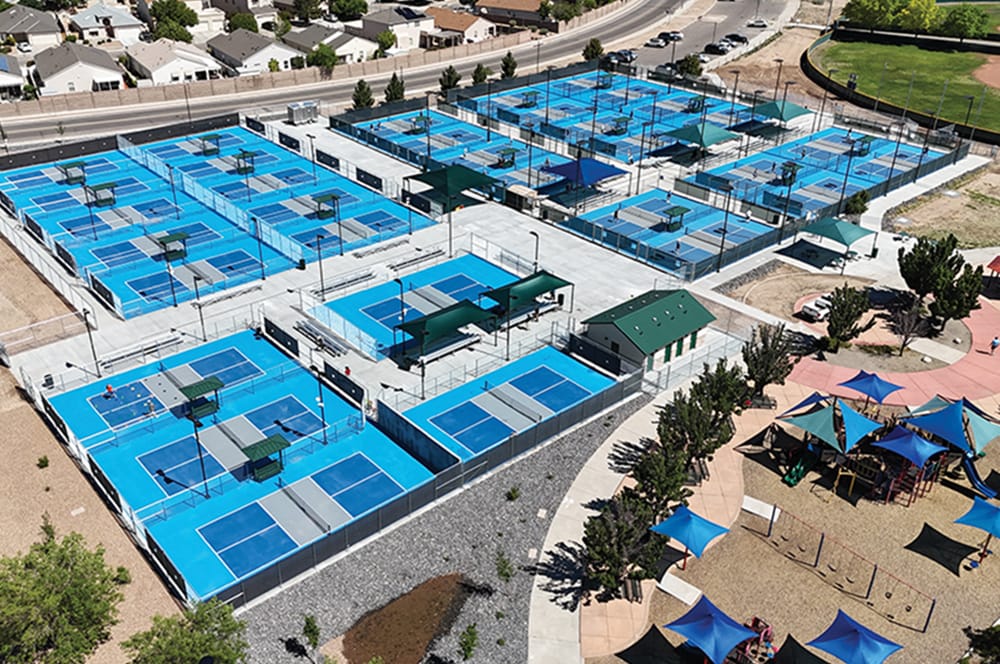How parks with sports facilities can serve the public and keep the peace
Conventional wisdom dictates that good fences make good neighbors, but when it comes to sports facilities (e.g., courts, fields, pathways, and the like), the issue is more complex. And for sports venues in parks, which are often in the middle of urban or suburban centers, the concept of being a good neighbor gains even more importance.
“Each facility has a responsibility to be a good neighbor and to minimize negative situations for adjacent neighborhoods,” says Mike Munie of Perfect Playfields and Links, LLC in Belleville, Ill. “Most neighborhoods around athletic facilities have a mixture of people; some are excited at the prospect of living very close to a venue, and some are irritated to varying levels by the events and the crowds.”
So, how can park management mitigate sources of complaints as much as possible?
Resident-First Parking
In some cases, it’s a matter of looking not at the facility itself but at the peripherals.
“Provide appropriate traffic control and security when needed,” says John Rombold of AstroTurf Corp, in Dalton, Ga.
This is a crucial point. As more parks rush to respond to the demand for venues like pickleball courts, sports fields, basketball courts, and upgraded playgrounds, leaders sometimes fail to consider the additional load this creates on surrounding infrastructure. As a result, complaints arise because of traffic congestion caused by athletes and their families who circle the streets, looking for parking spots and using residents’ designated spaces.
Admittedly, parking is less glamorous than putting in new sports facilities, and it’s easy to brush it off for later consideration; however, planning for it at a project’s outset provides a better result.
Another factor, says Rombold, is to ensure “there are storage facilities/garages for construction and maintenance vehicles and equipment,” so they do not sit on neighborhood streets and take up parking spaces during construction.

Functional Lighting
Lighting is a hot-button topic when sports facilities are located in or near neighborhoods. Years ago, high-intensity discharge (HID) lighting fixtures had unfortunate side effects, like causing a bright glow in the sky above a field, track, or court that was visible for miles. An inability to limit such features to the playing area caused a spill of light, dubbed “light trespass,” that could illuminate neighborhoods far beyond the perimeters of the sports facility, leading to complaints. The fixtures also caused glare in playing areas.
Today’s LED lighting has reduced the problems of sky glow, glare, and light trespass; however, steps can be taken in the construction or supply phase to cut down on the possibility of friction with neighbors.
“Shorter mounting heights of lights are likely to have less impact on neighbors and keep the price down for materials and foundations while still meeting the lighting requirements,” says Bill Hein of NLS Lighting, LLC in Carson, Calif. “Windscreens on a court are a necessity as well” since they help contain the light.
Because park equipment is sometimes purchased by staff members who lack knowledge of sports facilities, Hein says parking lot lights are mistakenly procured instead of sport-specific fixtures. These “create too much player glare and shadows compared to fixtures designed and engineered specifically for sports lighting.”
Unlike many other types of fixtures, LED lighting can be dimmed when the facility is not in use so lights do not bother those in adjoining homes but do maintain enough illumination for security purposes.
Community Input
One aspect of facility design and construction that’s often overlooked is input from neighbors. Those who stand to be affected by the facility want to be consulted. By organizing community charettes, appearing at neighborhood meetings, and keeping the lines of communication open, it is possible to create harmonious relationships.
“I believe one of the best ways to be a good neighbor with a new or retrofit sports facility is to have good and open communication before construction begins,” says Boyd Crane of Nemaha Sports Construction in Lincoln, Neb. “Have meetings before any shovels hit the ground with everyone involved on the owner’s side, including the owner [or park officials], engineers, contractors, etc., and the adjoining neighbors. Try to alleviate concerns before they become real issues.”
“There is always the chance of having that neighbor who will be unhappy regardless of anything facility personnel can say or do,” Munie says, “but the goal should always be to avoid that scenario.”
Part of communication, adds Charles Dawson of Geosurfaces in Mooresville, N.C., is keeping community members updated on various aspects of the project, and being prepared for some pushback. He points to artificial turf as an issue that might bring up strong feelings.
“You can be assured no space or classroom will positively impact more community members than this playing surface,” he says.
It can help to bring along the latest research about artificial-turf safety; for example, in April 2024, the Environmental Protection Agency (EPA) published a multi-agency research report on synthetic-turf sports fields that use crumb rubber infill. The findings showed no significant difference in the exposure to certain chemicals between players who played on synthetic-turf fields that used crumb rubber infill and those who played on grass fields.
That’s far from the only impact a facility can have on a neighborhood. Come prepared to discuss operating hours (and whether the facility will be locked when not in use), as well as any noise-mitigation measures that will be taken for the comfort of nearby residents. The sports-facility contractor can provide information on products that can help with the latter issue.
Rombold says other actions that can win points with the neighborhood include the following:
- Build with a design/façade that matches the neighborhood’s character, including landscaping.
- Be a leader in sustainability, including measures like recycling, a hardscape runoff plan, use of native plants, and low-maintenance landscaping.
- Utilize a community alert system or neighborhood Facebook pages (or other social media) to announce large events that may have an impact on traffic. (Note: It is helpful to notify residents well in advance of events, and to include the hours the event will take place.)
- Provide affordable time slots for the area’s economically disadvantaged youth teams.
Another way a facility can be a good neighbor is to ensure trash and recycling are collected daily, cutting down on the potential for vermin like rats and raccoons.
“When we attend or participate in a sporting event, we do not often think about the impact that event and facility have on the surrounding community,” says Munie. “While we will never please everyone, the goal should certainly be to mitigate annoyances and minimize the possibility of having disgruntled neighbors as much as possible.”

